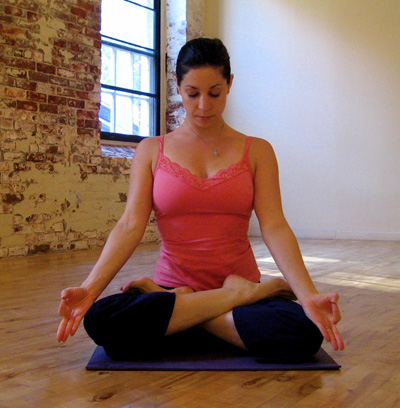Introducing Meditation Into Your Yoga Practice
Outdoor Meditation

What is Meditation?
Modern day living conditions bring in a lot of stress and anxiety to one's every waking moment. There's been several things to attend to at work or home that stress builds up over time until your body breaks down. Meditation will help you cope with all these turmoil. It goes hand in hand with developing positive thinking habits that allow you to lead a normal daily living. According to yoga and meditation experts, it makes you fully aware of the present while living in it.
Meditation

Yoga Meditation Intro
Yoga and Meditation Videos on Amazon
Principles of Meditation
There are 12 principles observed during meditative practice. If you want to experience maximum benefits, it is best to follow each one of the following:
- Find yourself a specific place intended for meditation. If possible, use this spot during your regular meditation.
- When it comes to choosing the right time to perform meditation, choose a time of day that provides the least amount of mental and physical distraction. Your mind must also be at ease since it is crucial in helping you meditate more effectively.
- Follow the time and place you have determined above so you can perform a regular meditative practice. Then, control your mind to slow down its processes.
- Position yourself such that your head, neck, and back are properly aligned.
- Control your mind's ability to remain still for the entire length of your meditative session.
- Regulate your breathing pattern by starting with deep breathing methods. After 5 minutes, you can slow down your breathing.
- After the initial breathing methods, you can produce a rhythmic pattern to your breathing, with about 3-second interval between inhaling and exhaling.
- If you find that your mind is restless at start, let it wander until you find the ability to concentrate.
- Find a focal point where you can focus your mind, it could be an image or thought.
- Having chosen your object of concentration, you can now use a specific meditation technique to hold that focus for the entire length of the session.
- If you are successful, you will find that your mind is able to reach the stage of pure thought while remaining aware of the physical surrounding – known as duality.
- Once you have reached duality, it ultimately leads to you attaining a superconscious state.
Meditation for beginners
Basic Meditation Posture

How To Do the Lotus Pose
Yoga Meditation Books
Yoga Seated & Supine Poses : Half Lotus Yoga Pose
Kundalini Yoga for Beginners : Proper Meditation Breathing for Yogic Meditation Training
Basic Meditation Poses
There are four basic meditation poses that you need to learn. They are each discussed below:
*Full Lotus Pose: This is considered as the perfect meditation posture, something of which you might immediately associate with meditation once you see it executed. This particular pose provides a comfortable and relaxed state for your body as your back is positioned perfectly straight.
*Half Lotus Pose: As opposed to the full lotus pose, only one leg is placed under one of your thighs. This is often used as a warm-up pose to the Full Lotus.
*Burmese Pose: This is probably the simplest meditation pose with your knees down and spread apart. Meanwhile, your legs are folded and your feet are pulled in front of your pelvis. While your hands are cupped, rest them on top of your thighs. It is advised that you have a firm and comfortable cushion.
*Egyptian Pose: This one is done while sitting on a chair that enables you to sit upright and providing enough support for your head. Then, cup your hands and rest them limply on your lap with your wrists on top of your thighs.
Meditation Exercises
Meditation is necessary in practice of yoga as it culminates your progression towards emotional stability. With too many stresses – physical, mental, and emotional – affecting every individual on a regular basis, executing proper meditation exercises will help get you started towards an inner journey. Here are a few you should try:
*Yoni Mudra – It enables your five senses to control the information that it is able to absorb.
*Category Concentration – This exercise is intended to narrow down your focus so you can concentrate only on objects that help you attain a deeper state of mind.
*Walking Meditation – This is one of the simplest exercise you can do to let loose and start an uninitiated drive towards mental focus.
*Journey Meditation – This requires visualization to achieve the desired meditative state and is best suited for those with immense visualization capabilities.
*Instant Calming Sequence – This is a technique that will help provide relief and soothe your senses following a shocking or traumatic event.
Choosing Your Own Medication Technique
There are various meditation techniques available for you to choose from upon deciding to embark on a yoga practice. Basically one thing will determine your choice above all else and that is your meditation goals.
Whether it be achieving the proper relaxation state or gaining a greater insight into your emotional experience, then there is one meditation practice suited for that. So, always begin by educating yourself about the principles and techniques of meditation so everything else will be smooth-sailing.
Importance of Meditation
Meditation is a major feature in yoga practice for one basic reason – it has its own set of beneficial effects that is necessary in yoga. The duality mentioned in the principles of meditation refers to your ability to maintain proper perspective of your thoughts and inner state of mind, despite realizing what is going on at present in the physical world.
As you know, there are several factors that could bring about distraction while you are performing yoga. Hence, your ability to block out those external thoughts is a key factor in determining whether you are successful in yoga or not.
Yoga relaxation pose meditation
Meditation as One Of Yoga Principles
If you are aware of
the five basic yoga principles, then you will realize that meditation
is the final stage in most yoga practice at which all other principles
lead up to. When you reach this stage of your yoga practice, it implies
your full control over the mind. When you are properly meditated, your
senses and awareness of the immediate surrounding is sharper than ever.
That way, you are fully aware of your 'self' and the surrounding at
which that 'self' belongs to, and yet being able to block them out at
the same time.
How Does Meditation Improve Yoga Practice?
Meditation
is vital in yoga for the same reasons why it is included among the five
principles of yoga practice. Unless you have proper meditation
techniques, you will never be able to establish awareness of your
physical and spiritual body. The latter is crucial in attaining a
deeper sense of purpose and expanding your strength of will.
The
ability to attain clarity of mind and find the tranquility you need to
set the stage for a successful yoga experience is what makes meditation
always a prerequisite for yoga. Hence, these two must always come
together to gain full benefits.










